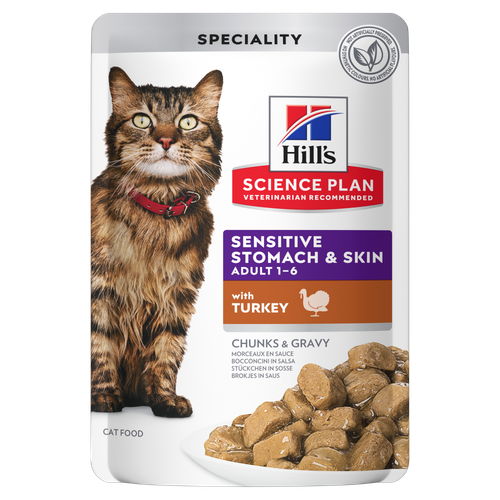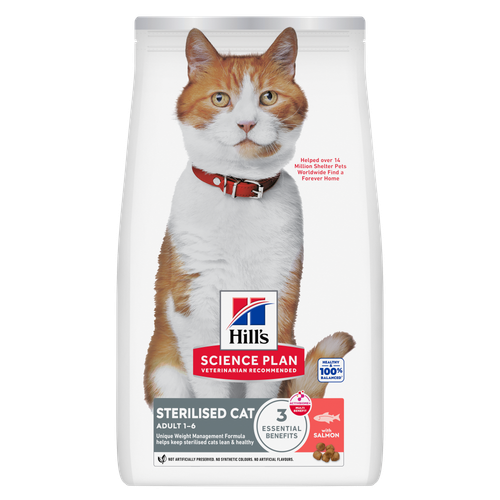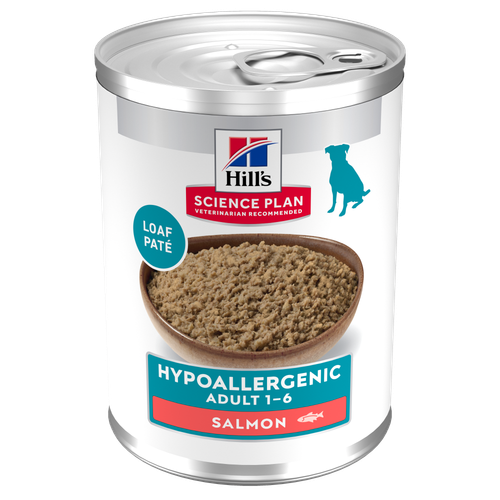
-
Find the right food for your petTake this quiz to see which food may be the best for your furry friend.Find the right food for your petTake this quiz to see which food may be the best for your furry friend.Featured products
 Adult Wet Dog Food with Beef
Adult Wet Dog Food with BeefHill's Science Plan Adult Multipack Wet Dog Food with Chicken, Beef & Turkey are complete premium pet foods for adult dogs from 1 year. Your dog will love these deliciously smooth and savoury minced loaves, formulated for balanced nutrition and overall health.
Shop Now Mature Adult Dog Food
Mature Adult Dog FoodHill's Science Plan Mature Adult Multipack Wet Dog Food with Chicken & Beef are complete premium pet foods for mature adult dogs from 7 years. Your dog will love these deliciously smooth and savoury minced loaves, formulated to deliver the appropriate amount of energy to support the needs of adult dogs.
Shop Now Puppy Food
Puppy FoodHill's Science Plan Puppy Multipack Wet Dog Food with Chicken & Beef are complete premium pet foods for growing puppies from weaning until 1 year old and for pregnant and nursing dogs. Your puppy will love these deliciously smooth and savoury minced loaves, formulated for balanced nutrition and overall health.
Shop NowFeatured products Sensitive Stomach & Skin Adult Cat Food
Sensitive Stomach & Skin Adult Cat FoodHill's Science Plan Sensitive Stomach & Skin Adult Wet Cat Food with Turkey is a complete pet food for adult cats, aged 1–6 years. This highly digestible wet food comes in a pouch and supports healthy digestion, as well as nourishes skin and promotes a thick and lustrous coat.
Shop Now Sterilised Adult Cat Food
Sterilised Adult Cat FoodHill's Science Plan Adult Sterilised Cat Dry Food with Salmon is specially formulated with ActivBiome+ Multi-Benefit Technology. It is a precisely balanced nutrition, tailored to meet the needs of sterilised cats, to help keep them lean & healthy.
Shop Now Hairball & Perfect Coat Adult Dry Cat Food with Chicken
Hairball & Perfect Coat Adult Dry Cat Food with ChickenHill's Science Plan Hairball & Perfect Coat Adult Cat Food with Chicken is formulated to effectively help avoid hairball formation in adult cats while promoting a beautiful coat. Thanks to its mix of essential omega-6 fatty acids, this food benefits the cat's skin and fur, keeping them healthy and shiny. Our Advanced Fibre Technology helps reduce hairballs by naturally promoting their passage through the gut. This food is formulated with high-quality protein for a perfectly balanced, great-tasting recipe.
Shop Now -
Dog
- Dog Tips & Articles
-
Health Category
- Weight
- Food & Environmental Sensitivities
- Urinary
- Digestive
- Joint
- Kidney
-
Life Stage
- Puppy Nutrition
- Adult Nutrition
- Senior Nutrition
Cat- Cat Tips & Articles
-
Health Category
- Weight
- Skin & Food Sensitivities
- Urinary
- Digestive
- Kidney
-
Life Stage
- Kitten Nutrition
- Adult Nutrition
Featured articles The Incredible Science Behind Your Pet's Microbiome
The Incredible Science Behind Your Pet's MicrobiomeLearn what your pet's microbiome is, how it contributes to your pet's gut and overall health, and why nutrition is important in maintaining healthy microbiomes.
Read More Show some love with wet foods: a great choice for pets with health issues
Show some love with wet foods: a great choice for pets with health issuesShow some love with wet foods: a great choice for pets with health issues.
Read More The Right Diet For Your Pet
The Right Diet For Your PetIn people, the right diet is very important. If you are eating the wrong way for your metabolism, activity level, age and lifestyle you could end up with health issues.
Read More -


Congratulations! You and your family are about to adopt a small breed dog. You've researched everything, from the best toys for small dogs to how to take your dog on holiday, but you should also be aware of some of the most common small dog health problems.
Of course, just because some health problems are common for small dogs, it doesn't mean your new family member will experience them. But as a caring pet parent, you want to be prepared for all the happy, playful times, while also knowing what to expect if anything were to go wrong. Read on to learn more about five common health problems that small dogs may face.
1. Dental disease
Good dental care is important for all dogs, but due to their crowded teeth, amongst other reasons, small breed dogs have a higher risk of developing dental issues. The first sign of dental problems is often bad breath, but you may also see tartar buildup on the teeth and reddened gums. As dental disease progresses, it can cause pain, infection, loose teeth and trouble eating.
It’s important to make sure you have a good routine in place to try and keep your dog’s teeth clean. Daily toothbrushing is the gold standard, but this habit should be started at puppy age because it can be more difficult to establish in older dogs. There are a number of foods, treats and doggie toothpastes available to help. Make sure to check the packaging for the Veterinary Oral Health Council (VOHC) seal to ensure you choose a product that works. Your veterinarian can also recommend specific products that may help your dog and will let you know when a full dental cleaning is needed.
2. Patella luxation
Patella luxation. The patella is what is commonly called the kneecap. It sits in a groove at the bottom of the thigh bone and should be firmly held in place by the tissues around the knee joint. In some dogs, particularly small breed dogs, the kneecap slips out of position and this is called luxation. It happens for a variety of reasons. The groove may be too shallow, the legs may be twisted or bent or the tissues too lax to hold it in place.
The severity of this condition varies with some dogs having a kneecap that very occasionally dislocates, which is obviously sudden and painful, to kneecaps that are so loose that they are constantly floating and never in place.
Dogs with patella luxation may not always show overt signs, but most will carry their affected limb for a few steps and “skip” or shake their leg before returning to normal walking. This lameness generally becomes more frequent as the condition progresses and arthritis can develop. Treatment can vary depending on the severity, with surgery being recommended in more serious cases. If you notice your dog limping or “skipping”, your veterinarian should evaluate your dog and provide you with the best management or treatment options.
PDSA reports that toy and miniature breed dogs such as Poodles, Chihuahuas, Yorkshire Terriers and Pomeranians are most commonly affected.



Tasty Tips
3. Tracheal collapse
The trachea, often referred to as the windpipe, is composed of small rings of rigid cartilage held within a soft tissue tube. The cartilage rings hold the airway firmly open to keep airflow unobstructed. Tracheal collapse is a chronic, progressive condition where the cartilage rings lose some of their rigidity. This allows the tube to sag and in some cases become occluded. This can make it difficult to breathe, particularly during exercise or times of stress when the need for oxygen is increased and an open airway is more important than ever.
Most dogs who experience tracheal problems are of middle age or older, though it can occasionally affect younger dogs. The most common sign of this problem is a dry, harsh cough that is sometimes referred to as a “goose honk” cough. It tends to be worse at night, with excitement, or when a collar is pulling on their neck. If your dog is coughing, it’s important to consult your vet. Coughing can also be a sign of things such as heart disease or infection so it’s important to find out the cause. Tracheal collapse can be difficult to treat but obesity makes it worse so try to keep your dog slim throughout life.
4. Mitral valve disease
One of the more serious small dog health problems takes place in the heart. During the ageing process, the valves of the heart may begin to “wear out” and leak, causing the heart to work less effectively. A leak in the mitral valve, one of the major valves on the left side of the heart, is called mitral valve insufficiency or mitral regurgitation. This condition has a genetic basis and is seen much more commonly in certain breeds such as the Cavalier King Charles spaniel.
Not all dogs with mitral valve disease will show signs, but the PDSA lists the most common symptoms as low energy, breathlessness, panting, weight loss and collapse. Another common symptom is coughing that gets worse at night, or after sleeping or lying down.
Dogs with severe mitral valve problems can be at risk for congestive heart failure. This is the end stage of many heart diseases including mitral valve disease. The longer the heart beats inefficiently the greater the workload becomes because the blood is pooling in the heart and the blood vessels before it, and not being pumped out properly. With time the heart gets bigger and bigger because of this and the walls become weaker and even less efficient. This is a deadly vicious circle. The pressure from the pooled blood pushes fluid into the lungs and extremities causing oedema. So, you can see that it’s important to visit your vet as soon as possible if your dog shows signs so that medication can be started if necessary. Your vet will check for a murmur using a stethoscope, and may wish to perform other tests like ultrasounds, x-rays or ECGs (used to check your dog’s heart rhythm).
Unfortunately, there are no preventative methods you can take to avoid this condition. However, regular checkups mean that your veterinarian can catch the problem as early as possible and provide you with a plan for monitoring and care. When choosing your small breed dog, always do your research and only buy from breeders that have heart-tested the parents in the commonly affected breeds.
5. Obesity
While it can be tempting to give your small dog lots of treats, it is important to remember that this can lead to weight gain. Overweight dogs may have trouble getting around and may be at risk for other diseases such as arthritis. Signs your dog might be overweight include not being able to easily feel their ribs and the loss of an obvious waist.
Make sure that you’re feeding your dog the correct amount of food for their ideal weight, offering a limited number of small treats, and giving them enough opportunity to exercise every day – even if they’re just playing with their toys at home or in the garden.
If you think your dog is overweight, or you’re not sure what their ideal weight should be, contact your veterinarian. They can help to get you started on an appropriate feeding plan.
Knowing some of the common small dog health problems your new dog may face helps you to ensure you’re doing everything you can to keep them healthy. But remember — just because your dog's size makes them a potential candidate for some of these health concerns, it doesn't mean they will ever experience them. Knowing what to look out for means that you can seek early treatment from your veterinarian or even avoid certain issues altogether.


Erin Ollila believes in the power of words and how a message can inform—and even transform—its intended audience. Her writing can be found all over the internet and in print, and includes interviews, ghostwriting, blog posts, and creative nonfiction. Erin is a geek for SEO and all things social media. She graduated from Fairfield University with an M.F.A. in Creative Writing. Reach out to her on Twitter @ReinventingErin or learn more about her at http://erinollila.com.
Related products

Hill's Science Plan Hypoallergenic Adult Wet Dog Food with Salmon is a complete premium pet food for all adult dogs from 1 year. This savoury tinned loaf is specially formulated for dogs with delicate skin and stomachs. It features a single novel animal protein source and is grain-free.

Hill's Science Plan Adult Multipack Wet Dog Food with Chicken, Beef & Turkey are complete premium pet foods for adult dogs from 1 year. Your dog will love these deliciously smooth and savoury minced loaves, formulated for balanced nutrition and overall health.

Hill's Science Plan Puppy Multipack Wet Dog Food with Chicken & Beef are complete premium pet foods for growing puppies from weaning until 1 year old and for pregnant and nursing dogs. Your puppy will love these deliciously smooth and savoury minced loaves, formulated for balanced nutrition and overall health.

Hill's Science Plan Mature Adult Multipack Wet Dog Food with Chicken & Beef are complete premium pet foods for mature adult dogs from 7 years. Your dog will love these deliciously smooth and savoury minced loaves, formulated to deliver the appropriate amount of energy to support the needs of adult dogs.
Related articles

Learn effective tips for feeding a dog that's a picky eater and ensure proper nutrition for a finicky eater. Discover tips for pet parents at Hill's Pet UK.

Learn about the potential health risks of a raw diet for dogs and why they aren't the best option for your pup or you.

Many human foods are dangerous to dogs. Read about 5 of the worst toxic food offenders that can kill your dog - and how much it takes to hurt them.

How, when and what to feed your new puppy is an important decision, learn more about the things to consider for feeding your puppy.

Put your dog on a diet without them knowing
Our low calorie formula helps you control your dog's weight. It's packed with high-quality protein for building lean muscles, and made with purposeful ingredients for a flavourful, nutritious meal. Clinically proven antioxidants, Vitamin C+E, help promote a healthy immune system.
Put your dog on a diet without them knowing
Our low calorie formula helps you control your dog's weight. It's packed with high-quality protein for building lean muscles, and made with purposeful ingredients for a flavourful, nutritious meal. Clinically proven antioxidants, Vitamin C+E, help promote a healthy immune system.

